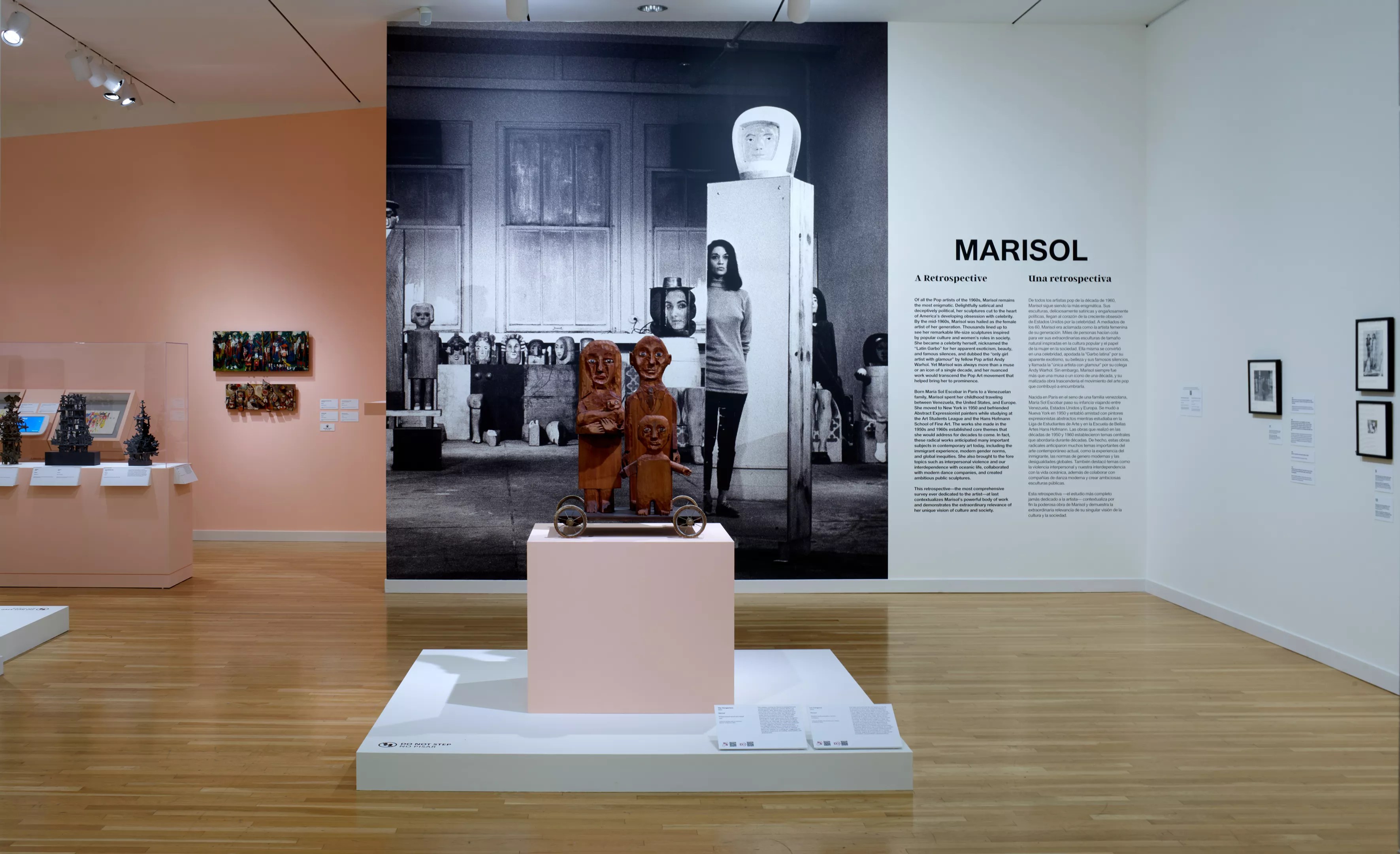
Courtesy of Dallas Museum of Art

Audio By Carbonatix
Enigmatic, uncompromising, and unsung, Marisol is perhaps the most incredible artist you’ve probably never heard of. Now, with the subject of an extensive and enticing retrospective on view at the Dallas Museum of Art, that status is (at least locally) changing.
“Marisol is an interesting figure vis-Á -vis Latin American Art,” says Dr. Anna Katherine Broadbeck, Hoffman Family Senior Curator of Contemporary Art at the DMA. “She was very much a New York-based artist and as influential in the New York art world as anyone else. She was also a towering figure for crossover artists. In recent years, we’ve tried to expand and be more representative of figures like Marisol, who was so important in the 1960s but had kind of dropped out of the official narratives.”
When Broadbeck learned that Marisol’s estate was left to the Buffalo AKG Art Museum after the artist’s death in 2016, she contacted her friend and colleague, AKG’s chief curator, Cathleen Chaffee, to see if the DMA could be on the roster of institutions to exhibit the work.
This effort allowed Broadbeck a front row seat to what ultimately became Marisol: A Retrospective, an enlightening exhibition of drawings, sculptures, video and collage art that helps illustrate what makes an artist an artist – from cradle to grave.
Born in Paris, France, to a wealthy Venezuelan family, the artist formerly known as Maria Sol Escobar was privileged enough to globetrot at a young age, exposing her to museums and architecture along the way. However, her mother’s suicide at age 11 traumatized her, which led her to not speak for several years.

Marisol, a contemporary of Andy Warhol, was one of the most influential artists launched from the pop art scene of the 1960s.
Courtesy of Dallas Museum of Art
Eventually, she studied at École des Beaux-Arts and the Art Students League in New York before spending some time in Rome. By the early 1960s, she began taking the New York art world by storm. At the height of her career, Marisol was so popular that more than 2,000 people lined up around the block to see one of her gallery shows.
Chaffee says the financial support of Marisol’s family allowed her the luxury of time to define her voice, which was influenced by everything from American folk art to pre-Columbian and Asian Art. Called “the first girl artist with glamour” (a back-handed compliment if there ever was one) by her friend and colleague Andy Warhol, Marisol became catnip for the likes of Vogue, Life, and Cosmopolitan, who loved to shoot models vamping in front of her sculptures in designer clothes.
“She was blessed or cursed by always knowing she wanted to be an artist,” says Chaffee. “Her rise didn’t start until she’d been in New York for seven years when (gallerist) Leo Castelli put her in a group show, then offered her a solo show. That show got a lot of attention, and she got overwhelmed by that attention – there was this feeling of not recognizing [the] version of herself she saw in magazines.”
The retrospective exhibit focuses heavily on the artist’s monumental sculptures. The works are incredibly personal (many have her own or a family member’s face) yet still feel instantly familiar to the viewer – wry, sarcastic and tender.

Though she explored various genres of art, Marisol was known for her signature take on Pop Art.
Courtesy of Dallas Museum of Art
In particular, the 1965/66 piece titled The Party could easily be a snapshot of the Dallas gala scene of the time. Blockish figures dressed in gowns and costume jewels (some drawn from Marisol’s own closet) stand in uncomfortable clusters while being waited on by a stoic butler and maid. Much like the artist’s works memorializing the Kennedy Family, Lyndon Baines Johnson and Pablo Picasso (also included in the exhibit), these satirical figures say more about the times they were made in than any political think piece.
At the height of her fame, Marisol left the art world, though she eventually returned with a series of aquatic sculptures inspired by her favorite hobby of scuba diving. She also began collaborating with choreographers, designing props and costumes, and highlighting awareness of violence against women through her work. This era may not have sold as well as she would have liked, but her expanding aesthetic illustrates how determined she was to pave her own path, regardless of what the art world wanted at the time.
“She was extremely determined to do what she felt was right at any given time, but that doesn’t mean you maintain continuity in the public eye,” says Chaffee. “She has not gotten written into the narrative around feminist art because people think she’s a pop artist, then she’s excluded from that canon [too] because people think she’s too folky. She goes against the grain in so many ways, but those are the figures that are most interesting in my opinion.”
Indeed, Marisol’s ability to hop genres and forms means there’s something in A Retrospective for everyone. It’s very telling that on multiple visits to the DMA, separate longtime security guards cited the exhibition as the favorite show they’d seen at the museum during their tenure.
For Chaffee, this is an obvious conclusion when viewing the work of such an ambitious talent.
“She was one of the first artists of this century taking up women’s roles in society, and the way she’s doing it is with a critical eye and a satirical eye on society,” says Chaffee. “There’s humor, there’s irony, there’s work about women’s lives and about celebrity and media and all these aspects we haven’t seen represented in art. I also find her work extremely poignant and moving – there’s something so relevant about her practice today.”
Marisol: A Retrospective is on view at the Dallas Museum of Art through July 6, 2025.